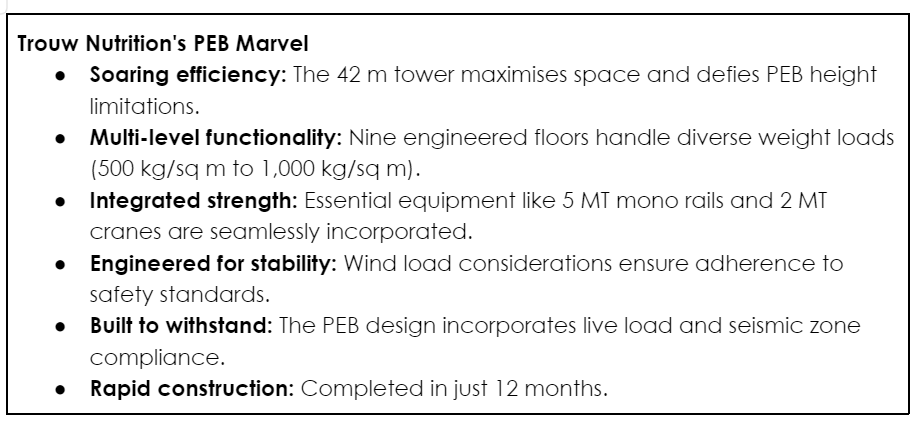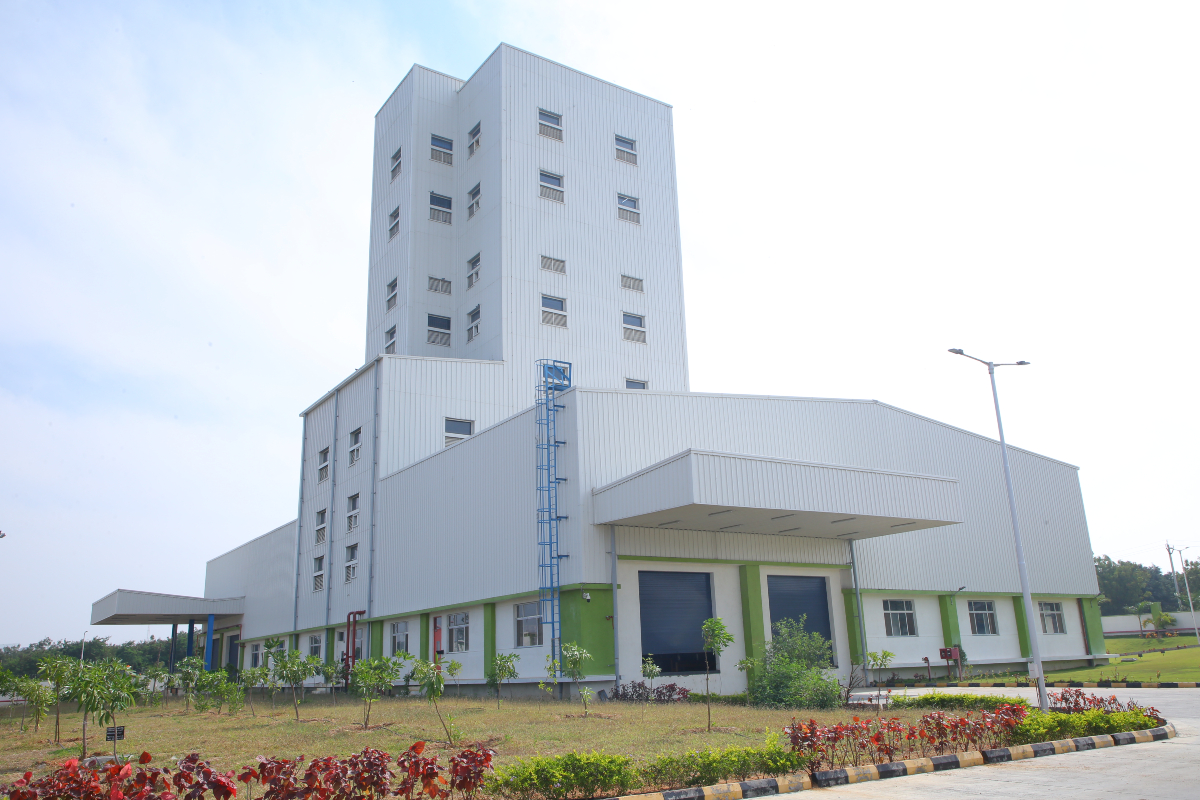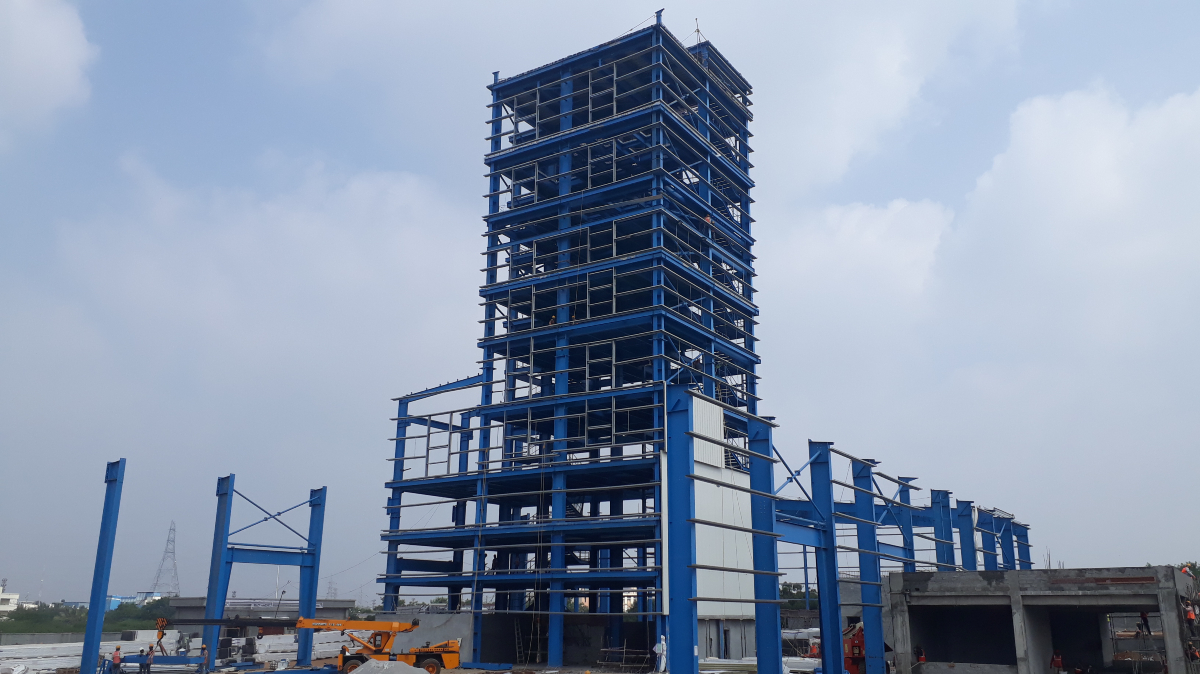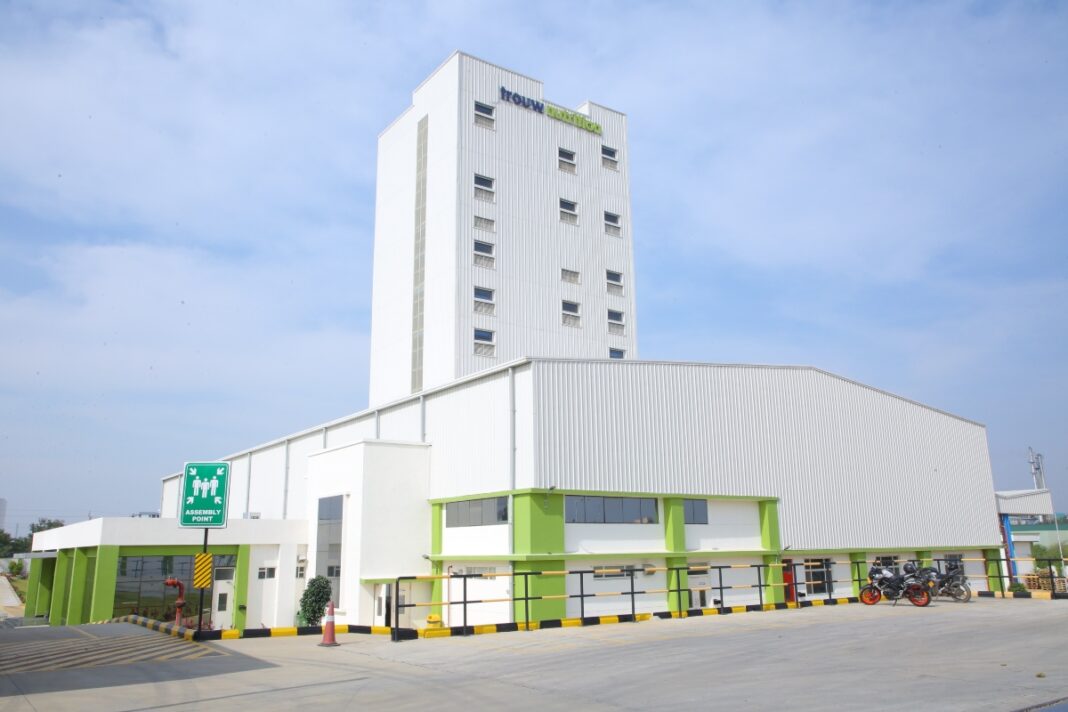With land costs ever-rising and efficient use of space becoming paramount in the industrial sector, traditional building methods are being challenged by innovative solutions. One such advancement is the multi-storey PEB (Pre-Engineered Building). This forward-thinking approach merges the strength, affordability, and rapid construction of PEB with the practicality of vertical expansion. By incorporating multiple floors, multi-storey PEB buildings offer a game-changing solution for industrial needs.
One such project is Trouw Nutrition India’s one-of-a-kind premix plant in Jadcherla, Telangana. This 5,000 sq m marvel stands as a testament to the power of multi-storey PEB design. Soaring 42 m tall, the structure boasts nine meticulously engineered floors capable of handling a staggering range of loads – from a substantial 500 kg per sq m to 1,000 kg per sq m. This allows for seamless integration of essential production equipment, including powerful 5 MT mono rails, 2 MT EOT cranes, and 2 MT underslung cranes.
But the brilliance goes beyond maximising space. The PEB design is built to withstand demanding conditions. It incorporates a live load of 75 kg per m on the metal roof, along with pipe rack loads of 1.5 kn per m on the columns. Further ensuring stability, the design adheres to a wind speed of 44.0 m per sec (Terrain category-1) and seismic Zone II compliance with IS-1893 regulations.
Completed in a remarkable 12 months, Trouw Nutrition’s project exemplifies the power of innovation and meticulous planning. It’s a shining example of how multi-storey PEBs can usher in a new era of efficient industrial design, paving the way for a more sustainable and space-conscious future.
Manish Shah, Director of MR Warerkar and Associates Pvt Ltd, and Navaz Malikakkal, COO of Interarch Building Products Ltd, shed light on the intricacies of the project.

Breaking new ground
As with any innovative project, Trouw presented its set of unique challenges. Primary among them was its height. Shah elaborates, “Even though our firm primarily deals in the design of factories and warehouses, this project was extremely challenging owing not just to the 9 storeyed 42 m tall tower but the multitude of heights being integrated into one PEB factory. With wind load being an extremely vital factor at that height, due care had to be taken to ensure all design parameters were accounted for.”
Malikakkal concurs and points out that the main challenges during the fabrication of the complex structure, specifically the 42 m tall tower, included adapting Pre-Engineered Building Systems designed primarily for low-rise constructions. Structural complexities with increased building height necessitated precise detailing and assembly skills. Moment-resisting rigid frames with star columns were considered for the stability of the tower area which needs complex fabrication. He adds, “Addressing wind and seismic actions posed additional challenges. Despite this, Interarch successfully engineered and fabricated the unique building, ensuring compliance with stringent design parameters and industry standards.”

Building on innovation
To optimise the fabrication process while upholding quality and safety standards, Interarch used innovative techniques and approaches. Firstly, a comprehensive 3D model was created using STAAD Pro software for structural analysis and design. Further, complete detailing was done in TEKLA for accurate fabrication drawings. This facilitated precise visualisation and analysis of the building’s complex geometry, ensuring accurate detailing and alignment of structural components. Additionally, in-house developed design tools were utilised for connection designs, enhancing efficiency and consistency.
The tower’s height demanded special attention. A dynamic analysis was employed using a response spectrum to ensure the structure’s earthquake resistance. This involved simulating seismic loads on the digital model, allowing the design of a structure that could withstand even the most demanding conditions.
Malikakkal elaborates, “Throughout the fabrication process, attention was paid to quality control measures, with stringent checks at each stage to maintain high standards. Collaborative efforts between design, engineering, and fabrication teams further streamlined processes, enabling seamless coordination and timely delivery of the project.” Overall, these innovative techniques and approaches optimised the fabrication process, guaranteeing superior quality and compliance of safety in the final structure.
Conquering the logistics maze
Delivering the massive components for Trouw Nutrition’s PEB marvel wasn’t a walk in the park. He delves into the strategies employed for a smooth process, “Firstly, we carefully coordinated transportation routes to ensure efficient delivery of materials to the construction site. We optimised packaging to minimise space requirements during transportation, maximising efficiency and reducing costs.” That apart, specialised handling equipment was utilised to safely handle heavy components, such as cranes, to avoid risks associated with material handling.
Moreover, on-site logistics management teams were deployed to oversee material handling and ensure smooth operations throughout the construction process. By prioritising strategic planning and leveraging appropriate equipment and resources, logistical challenges were successfully routed and project timelines and budgetary constraints were maintained.
Beyond the basics
The Trouw Nutrition project presented a unique opportunity to push the boundaries of PEB systems. Traditional pre-engineered building systems are primarily designed for low-rise constructions. However, this project pushed the boundaries by incorporating pre-engineered solutions for a high-rise structure. The various challenges underscored the importance of continuous research and development in structural engineering to meet the evolving needs of the construction industry.

Malikakkal states, “While we had already executed other process towers, this 42 m process tower had its own challenges. We learned the critical importance of ensuring structural integrity and stability, especially when dealing with increased wind and seismic forces for such tall process towers with heavy equipment. This experience emphasised the importance of planning, precise detailing, and robust engineering to guarantee the safety and performance of the structure.”
Dynamic analysis using the response spectrum played a crucial role in designing the building to withstand earthquakes. Interarch’s experience on this project highlighted the importance of comprehensive seismic design strategies, including advanced analytical techniques. By leveraging their ability to integrate these tools into the design process, they were able to optimise seismic performance and ensure the structure met the highest safety standards.
The complexity of process buildings within the structure highlighted the importance of detailing skills to facilitate precise manufacturing and bolted assembly at the site. He further adds., “We emphasised more attention to detail and streamlined manufacturing processes which are essential for ensuring the quality, accuracy, and efficiency of fabrication. This experience reinforced the importance of collaboration between design, fabrication, and installation teams to streamline workflows and minimise errors during the construction phase.”
The successful completion of the Trouw Nutrition project serves as a beacon for the future of industrial construction. This pioneering project demonstrates that pre-engineered steel buildings can reach new heights, offering a space-saving and efficient solution for complex industrial needs. As the industry grapples with rising land costs and a growing demand for efficient use of space, multi-storey PEB technology stands poised to revolutionise the way factories of the future are designed and built.
Quote
“Several design workshops were held between us, the client and Interarch to ensure the design was sturdy and economical, at the same time meeting all process and fire-fighting requirements for placing various machines, piping, cutouts etc. The erection of such a high tower was a challenge, considering limited space, and giving work front to other agencies. The tower was clad with panels from outside, for aesthetic, fire fighting and comfort requirements.”
Manish Shah, Director of MR Warerkar and Associates Pvt Ltd
“Our experience as the supplier on this project has been immensely enlightening, challenging, and rewarding. We have committed to delivering quality and performance in every project we undertake by addressing the challenges related to height, adapting to pre-engineered systems, prioritising seismic resilience, emphasising detailed precision, and following compliance with industry standards.”
Navaz Malikakkal, COO of Interarch Building Products Ltd
Fact File
Project: Medicated Animal Feed Factory, Telangana
Client: Trouw Nutrition Ltd
Architect & Consultant: MR Warerkar And Associates Pvt Ltd
Fabricator: Interarch Building Products Pvt Ltd
Tonnage: 650 tonne
Status: Completed





